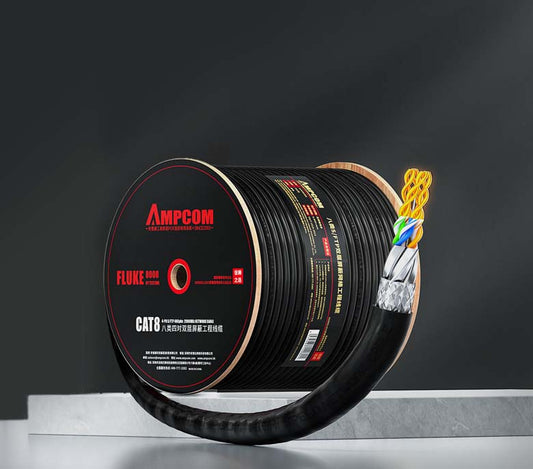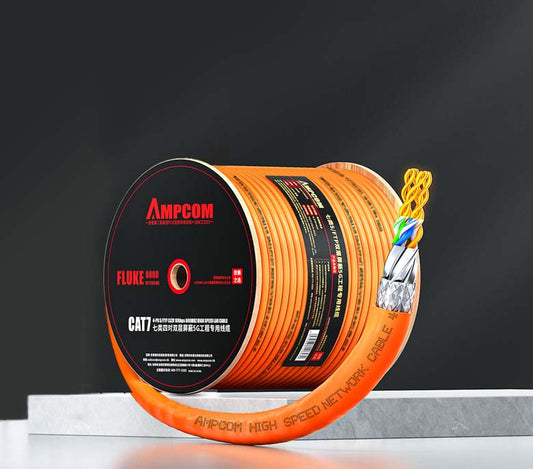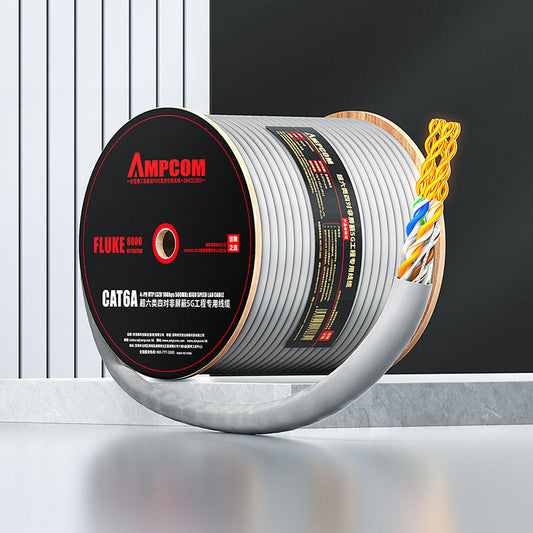Standard Evolution and Ecosystem Impact: The Shaping of Network Ecosystem by Cat5e to Cat8 Cable Technology Development
Introduction: Network patch cables, as the fundamental physical medium connecting network devices and constructing network topologies, do not evolve in isolation. Instead, their technical standards profoundly influence the evolution of the entire network ecosystem.
From the Cat5e designed to meet the needs of Fast Ethernet (100 Mbps) to the Cat6 supporting Gigabit Ethernet (1000 Mbps), and then to the Cat6a, Cat7 adapting to the Gigabit era, and finally to the Cat8 targeting high-speed connections in data centers, each upgrade in standards brings a leap in performance, triggering a chain reaction in devices, applications, operations, and even the entire industry ecosystem.
This article will trace the development of Cat5e to Cat8 patch cable technology, explore the differences and connections between various standards, and delve into how this evolutionary process has shaped and reshaped the network ecosystem we are in.
From "Chaos" to "Order": The Importance and Best Practices of Data Center Cable Management

Part 1: Evolution of Cable Standards: From Cat5e to Cat8
The evolution of network patch cable standards generally follows a pattern of roughly a ten-year cycle, with performance doubling (or more), driven by standardization bodies such as TIA/EIA (Telecommunications Industry Association/Electronic Industries Alliance) and ISO/IEC (International Organization for Standardization/International Electrotechnical Commission), aiming to meet the growing demand for network bandwidth.
Cat5e Network Patch Cables:
Background: Standardized (TIA 568.2-A, 2001) to meet the demands of Gigabit Ethernet (1000BASE-T).
Key Characteristics: Frequency reaches 100 MHz. Achieves support for Gigabit Ethernet transmission over up to 100 meters through stricter crosstalk control, particularly Far-End Crosstalk (FEXT).
Ecosystem Impact: Promoted the popularity of Gigabit Ethernet in small and medium-sized enterprises and homes, becoming the most mainstream cabling standard for over a decade. Spurred the development of a vast array of Gigabit-capable devices such as switches, routers, and network interface cards.
Cat6 Network Patch Cables :
Background: Built upon Cat5e to further enhance performance, preparing for even higher speeds (like 10 Gbps).
Key Characteristics: Frequency increased to 250 MHz. Improved cable structure and stricter control over pair untwist length enable support for 10 Gigabit Ethernet (10GBASE-T) over shorter distances (typically within 55 meters, depending on channel configuration). Available in both Unshielded (UTP) and Shielded (F/UTP, S/FTP) versions.
Ecosystem Impact: Provided the physical layer foundation for deploying 10Gbps networks in data centers and high-end office environments. Accelerated the maturation of the 10G network equipment market. The introduction of shielded versions began to make network engineers pay more attention to electromagnetic interference (EMI) issues in installation environments.
Cat6a Network Patch Cables :
Background: An "augmented" version of Cat6, specifically designed for Gigabit Ethernet and meeting longer transmission distance requirements.
Key Characteristics: Frequency significantly increased to 500 MHz. Capable of supporting Gigabit Ethernet stably over a full 100-meter channel length. Almost exclusively uses shielded designs (F/UTP or S/FTP), demanding higher installation craftsmanship, especially for termination and shield grounding. Typically features thicker conductors, requiring larger minimum bend radii.
Ecosystem Impact: Became the mainstream choice for new data center and large enterprise network cabling. Increased skill requirements for installers, driving the adoption of more precise termination tools and pre-terminated solutions like punch-down-free options. Shield grounding issues became a critical factor that must be carefully considered in network design and construction.
Application and Customized Design of Cable Tracers in Specific Industries
Cat7 Network Patch Cables :
Background: Aimed to provide higher bandwidth and EMI immunity to meet future high-speed network demands. First standardized by ISO/IEC, later TIA released related standards (TIA 568.2-D).
Key Characteristics: Frequency reaches 600 MHz. Designed with the intent to support up to 10 Gbps rates, but the standard did not specify speeds, and recommended special connectors (GG-45, TERA). In practical applications, more often uses RJ45-compatible connectors, supporting Gigabit speeds, but not fully realizing its performance potential. Generally adopts full shielding design (S/FTP), requiring reliable grounding of both ends of the shield.
Ecosystem Impact: Introduced stricter shielding and grounding requirements, further reinforcing the awareness of EMI control. Its design philosophy (high shielding, high frequency) laid the foundation for subsequent standards. Due to the lack of widespread adoption of GG-45/TERA connectors, its RJ45-compatible version, while offering performance close to Cat6a, comes at a higher cost, leading to a complex market positioning and ecosystem development.
Cat7a Network Patch Cables :
Background: An enhanced version of Cat7, further improving performance to accommodate higher data rate demands.
Key Characteristics: Frequency increased to 600 MHz. The main advantage lies in improved performance margin at high frequencies, enabling more stable support for Gigabit speeds and the potential to support even higher rates (like 25G/40G).
Ecosystem Impact: Further solidified the application of high-shielded cabling in specific scenarios (such as healthcare, industrial control). However, its influence in the data center field was relatively limited due to the rapid rise of Cat8.
Cat8 Network Patch Cables :
Background: Specifically designed for high-speed connections within data centers over short distances (e.g., intra-rack, inter-rack).
Key Characteristics: Frequency reaches 2000 MHz. Specifically designed to support 25GBASE-T/40GBASE-T (up to 30 meters) or 100GBASE-T (up to 25 meters). Almost exclusively uses full-shielded designs (S/FTP or SF/FTP), with extremely strict grounding requirements for the shield. Also places the highest demands on the installation environment and equipment interfaces.
Ecosystem Impact: Marks the evolution of cable technology towards ultra-high speed, short-distance, and high-density connections. Directly drives the optimization of internal data center network architectures (like Clos networks), providing the physical foundation for the proliferation of 40G/100G and even higher speeds. Its high cost and stringent installation requirements have also prompted the industry to explore the application of fiber optics in short-distance data center connections (such as AOCs, DACs).
Investment vs. Return: Evaluating the Value of Cat7/Cat8 Cables in Data Centers and HPC

Part 2: Technical Differences and Ecosystem Impact Analysis
The technical differences between various categories of cables directly or indirectly shape multiple aspects of the network ecosystem:
Performance Differences and Device Evolution:
Speed Driver: The performance improvements in cables directly drive the evolution of network equipment (switches, NICs, routers) towards higher speeds. Without Cat6a/Cat8 cables, there would be no large-scale deployment of Gigabit, Forty Gigabit, or Hundred Gigabit network equipment. Conversely, the increase in device speeds places higher demands on cables, creating a mutually reinforcing cycle.
Latency and Reliability: The lower latency and higher reliability brought by high-performance cables (especially shielded designs) provide the foundation for latency-sensitive applications (such as real-time audio/video, financial trading, remote healthcare) and services requiring 24x7 stable operation (such as cloud services, critical business systems).
Installation and Operations Ecosystem:
Increasing Skill Requirements: From Cat5e to Cat8, the skill requirements for installers have become increasingly demanding. Cat6a and above impose stricter requirements on termination techniques, shield grounding, bend radii, and cable management. This has driven the industry to demand more professional training, certifications, and tool support.
Importance of Testing and Verification: As cable performance improves, simple "plug-and-play" testing is no longer sufficient to guarantee quality. The use of certification-grade test equipment has become common, and testing standards and procedures have been incorporated into project acceptance criteria. This has spurred the maturation of the testing equipment and testing service markets.
Cable Management Complexification: High-performance cables are typically more expensive, and troubleshooting failures can be more complex. This further highlights the importance of standardized cable management (labeling, organization, documentation), driving the demand for cable management system software and automated tools.
Cost and Market Landscape:
Cost Curve: The improvement in cable performance comes with an increase in cost. This has led to market stratification: Cat5e/Cat6 mainly targets cost-sensitive markets, Cat6a/Cat7 targets mid-to-high-end markets, and Cat8 primarily targets specific areas with extremely high performance requirements, such as data centers.
Fiber Competition and Convergence: In the ultra-high-speed domain (such as above 100G), fiber optics (e.g., OM3, OM4, OM5 multimode fiber and single-mode fiber) compete with Cat8 cables due to their higher bandwidth, longer transmission distances, and better EMI immunity. However, Cat8 still holds advantages in short-distance, high-density connection scenarios. In the future, we might see a convergence of fiber and copper in specific scenarios, or even a gradual replacement of copper by fiber in ultra-high-speed short-distance connections.
Ecosystem Expansion of Applications:
Enabling New Applications: The improvement in cable performance has made many emerging applications possible. For example, Cat6a/Cat8 has enabled the large-scale deployment of 4K/8K video conferencing, VR/AR applications, and ultra-large-scale parallel computing. The shielding characteristics of Cat7/Cat8 also provide more stable connectivity for IoT devices and industrial control systems deployed in complex electromagnetic environments.
Driving Cloud and Edge Computing: High-performance networks are the foundation for the efficient operation of cloud data centers and edge computing nodes. High-speed internal connections using Cat8 cables in data centers provide low-latency, high-bandwidth support for cloud services and enable edge computing to process and transmit data more quickly.

Part 3: Challenges and Future Trends: Reflections from Standard Evolution
The continuous evolution of cable standards also brings some challenges and issues worth considering:
Standardization and Compatibility:
The GG-45/TERA connectors recommended during the initial design of Cat7 are incompatible with RJ45. Although the RJ45-compatible version solved the compatibility issue, it also brought the problem of ambiguous performance positioning. For future standards, how to balance innovation and compatibility, and avoid creating new ecosystem fragmentation, is an important topic.
Balancing Cost and Value:
The cost advantage of high-performance cables often manifests itself over the long term. During the initial investment, how to enable customers to fully understand the long-term value they bring (such as reducing failures, improving efficiency, avoiding premature replacement) is key to market promotion and project decision-making.
Installation Quality is Key:
No matter how high the standard, if the installation is non-compliant, the performance cannot be guaranteed. How to improve the standardization level and quality control capabilities of the entire industry (from design, construction to acceptance) is crucial to ensuring the realization of the value of cable technology.
The Tug-of-War Between Fiber and Copper:
In the ultra-high-speed network domain, fiber optics, with its superior performance, has become a strong competitor. Copper cables (such as Cat8) still have advantages in terms of cost and convenience for short-distance connections. How the two will divide roles and cooperate in the future is a trend worth continued attention. Some new types of copper cables (such as Cat8.1, Cat8.2) are also constantly trying to optimize performance at even higher frequencies.
Beyond the Physical Layer:
Cable technology is only one part of the network infrastructure. With the development of network architectures (such as disaggregated networking), Network Function Virtualization (NFV), and Software-Defined Networking (SDN), the importance of the physical layer cable remains, but its synergistic role with other network elements has become increasingly prominent. The evolution of the future network ecosystem will be the result of the joint action of hardware, software, protocols, and applications.

Conclusion: Standard Evolution, Ecosystem Shaping
From Cat5e to Cat8, the evolution of network patch cable standards has not only brought a huge leap in physical performance but has also profoundly shaped the ecosystem of network devices, applications, operations, and even the entire industry. Each leap in standards comes with technological innovation, cost considerations, skill challenges, and market competition. The application of high-performance cables (such as Cat7/Cat8) in data centers and high-performance computing fields is a concentrated manifestation of this standard evolution and value enhancement.
Understanding the evolutionary history and ecosystem impact of cable standards helps us better understand the foundation of our current network environment and make more informed decisions when planning future network builds. While pursuing higher performance, we must also pay attention to cost-effectiveness, installation quality, and ecosystem synergy. Network patch cables, as the "digital arteries" connecting everything, each advancement in their technology lays a solid foundation for a smarter, more efficient, and more reliable network world, and the entire network ecosystem continues to move forward through this ongoing evolution and interaction.



